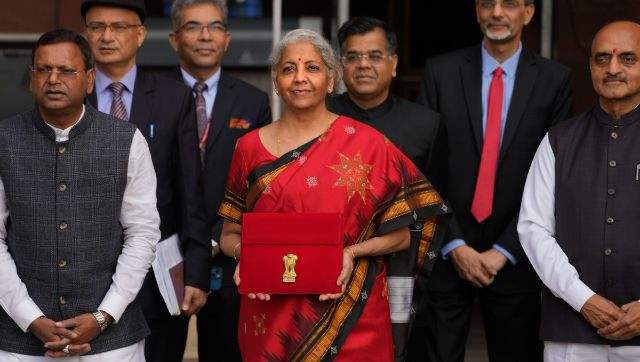The Union Budget was against the backdrop of a) need for fiscal consolidation amidst rising private credit, b) likely growth moderation in FY24 which could dent tax collection c) the need to address income weakness in middle-income households, while d) not losing an eye on multiplier effects of capex boost. The Budget has ticked all important boxes. There is a clear focus on preserving macro stability, focusing on productive spending, plugging the loopholes in tax avoidance, and targeting a gradual achievement of a level playing field for various financial products. Fiscal deficit to consolidate to 5.9 per cent in FY24 The fiscal deficit is expected to consolidate by 50 bps to 5.9 percent in FY24 with a vision to consolidate to 4.5 percent by FY26. At an absolute level, FY24 fiscal deficit is budgeted to increase marginally to Rs. 17.9 trillion (vs. 17.6 trillion in FY23RE). A massive increase in capex outlay alongside reduced tax liability on personal income tax is a twin approach to boost both infrastructure and consumption spending. Focused infrastructure spending Infrastructure spending is the key focus area. All the key pockets of infrastructure viz Roads (23 percent y-o-y), Railways (15 percent y-o-y), ports (24 percent), housing (66 percent), metro (26 percent), water and sanitation (33 percent) have seen a handsome increase in capex plans. Alongside, as expected, the 50-year interest-free capex loans granted to the states have been scaled up to Rs 1.3 trillion vs. FY23 RE of 850 billion. A host of significant capex-oriented sectors (urban infra, water, electricity, education, and healthcare) fall under the state/ concurrent list where active state participation is needed. Thrust to green transition has come via increased capex allocation for renewable energy, focus on renewable energy evacuation, and targeting adoption of green farming to name a few. There have been significant custom duty tweaks to support PLI/ manufacturing sector in India. While the aggregate allocation for key rural schemes is contained, some of the productive schemes pertaining to drinking water, housing, and irrigation have seen an increased allocation. Even as budgetary spend is contained, the infrastructure boost has a trickle-down effect on employment generation in rural India. Capex to GDP up The quality of expenditure has improved with capex to GDP rising to 3.3 percent of GDP (vs. sub 2 percent pre-COVID). On the other hand, there is a hope to reduce subsidy outgo, which in the end would be contingent on the evolution of commodity prices through FY24. FY24 fiscal math is a tad optimistic but not out of whack. The expectation of 10.5 percent nominal GDP growth in FY24 and 10 percent gross tax revenues may be a bit higher than what we have in mind (8 percent). The disinvestment target of Rs 610 billion and telecom receipts of Rs 890 billion budgeted for FY24 also look a bit aggressive. On the other hand, dividend assumptions appear conservative. Lack of clarity on GST compensation cess There is a lack of clarity on utilisation of GST compensation cess. As we know, compensation cess benefits for states have been discontinued since July’22. Yet compensation cess will continue to exist for at least until FY26 to honour the principal and interest payments for Rs 2.7 trillion GST loan availed in FY21 and FY22. Centre projects Rs 1.45 trillion of GST cess revenue collection in FY24, of which Rs 900 billion will be utilized to service the loan. It remains unclear if the remaining Rs. 500 billion will be utilized by the centre or parked elsewhere. If the former turns out to be true, it could help to tide over the revenue foregone under Income tax due to tinkering of tax liabilities. From a fixed income markets standpoint, the gross and net market borrowing at Rs 15.4 trillion and Rs 11.8 trillion respectively turned out to be better than market expectation. While the financing through NSSF appears slightly aggressive, we would watch out for the deposit-garnering capability of the new scheme (Mahila Samman Bachat Patra) and enhanced maximum deposit level under a few other schemes. New Income tax regime There is an effort to increase disposable household income by altering the threshold for taxable income- which in turn could help augur both consumption and savings. There is a clear focus to incentivise the adoption of the New Income tax regime. Even as the surcharge for high-income individuals has been reduced, the avoidance routes like Market Linked Debentures have been plugged in which could potentially dilute the popularity of the product and lead to a level playing field with debt MFs. Change in tax for insurance products There has been a change in taxation for insurance products that disincentivises products that used to provide long-term tax-free annuities. A large part of the demand for long-end G-secs used to come from these products. Effectively the tax break is now only for low-premium insurance products. This can affect the sales of these products and potentially steepen the curve as we get into the new financial year. At the same time, it is likely that the next 2 months could see a surge in sales by insurance firms. With regards to equity markets, the tax tweaks on income tax could help support urban consumption, while the infrastructure push is positive for related sectors. Autos could benefit from support for scrapping old government vehicles. We see the impact on insurance companies on tax measures/efforts to migrate taxpayers to the new tax regime. LTCG has been left untouched allaying the fears of the equity market. Prima-facie, budget 2023 should be cheered by equity and fixed-income markets alike. The writer is Namrata Mittal, CFA, and Senior Economist, SBI Mutual Fund. She tweets @Namrata_5. Views expressed are personal. Read all the Latest News , Trending News , Cricket News , Bollywood News , India News and Entertainment News here. Follow us on Facebook, Twitter and Instagram.
There is a clear focus on preserving macro stability, focusing on productive spending, plugging the loopholes in tax avoidance, and targeting a gradual achievement of a level playing field for various financial products
Advertisement
End of Article


)

)
)
)
)
)
)
)
)



